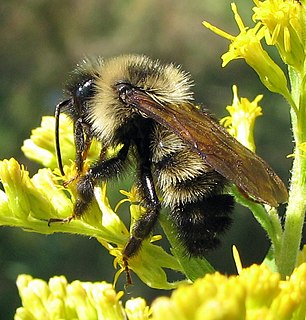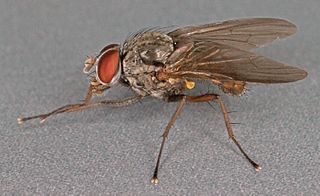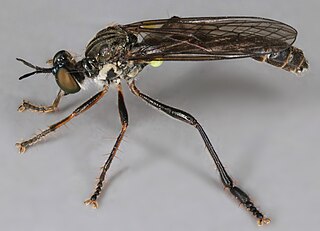
The Phoridae are a family of small, hump-backed flies resembling fruit flies. Phorid flies can often be identified by their escape habit of running rapidly across a surface rather than taking to the wing. This behaviour is a source of one of their alternate names, scuttle fly. Another vernacular name, coffin fly, refers to Conicera tibialis. About 4,000 species are known in 230 genera. The most well-known species is cosmopolitan Megaselia scalaris. At 0.4 mm in length, the world's smallest fly is the phorid Euryplatea nanaknihali.

Delias eucharis, the common Jezebel, is a medium-sized pierid butterfly found in many areas of south and southeast Asia, especially in the non-arid regions of India, Sri Lanka, Indonesia, Myanmar and Thailand. The common Jezebel is one of the most common of the approximately 225 described species in the genus Delias.

The Asilidae are the robber fly family, also called assassin flies. They are powerfully built, bristly flies with a short, stout proboscis enclosing the sharp, sucking hypopharynx. The name "robber flies" reflects their notoriously aggressive predatory habits; they feed mainly or exclusively on other insects and, as a rule, they wait in ambush and catch their prey in flight.

Curetis thetis, the Indian sunbeam, is a species of lycaenid or blue butterfly found in Indomalayan realm.

The Therevidae are a family of flies of the superfamily Asiloidea commonly known as stiletto flies. The family contains about 1,600 described species worldwide, most diverse in arid and semiarid regions with sandy soils. The larvae are predators of insect larvae in soil.

Tarucus ananda, the dark Pierrot, is a small butterfly found in India that belongs to the lycaenids or blues family. It was formerly placed in the genus Castalius, and with the delimitation of Castalius versus Tarucus being not fully resolved this may well be correct.

The Agromyzidae are a family commonly referred to as the leaf-miner flies, for the feeding habits of their larvae, most of which are leaf miners on various plants.

The Lonchaeidae are a family of acalyptrate flies commonly known as lance flies. About 500 described species are placed into 9 genera. These are generally small but robustly built flies with blue-black or metallic bodies. They are found, mainly in wooded areas, throughout the world with the exception of polar regions and New Zealand.

Rhagionidae or snipe flies are a small family of flies. They got their name from the similarity of their often prominent proboscis that looks like the beak of a snipe.

Bombus citrinus is a species of bumblebee known commonly as the lemon cuckoo bumblebee due to its lemon-yellow color. It is native to eastern North America.

Tachina fera is a species of fly in the genus Tachina of the family Tachinidae. It was first described by Carl Linnaeus in 1761.

Estigmene acrea, the salt marsh moth or acrea moth, is a moth in the family Erebidae. The species was first described by Dru Drury in 1773. It is found in North America, the Democratic Republic of the Congo, Kenya, Colombia and Mexico.

Beris clavipes, the scarce orange legionnaire, is a European species of soldier fly.

Pegomya winthemi is a species of fly in the family Anthomyiidae. Found in North America, it was first described as Anthomyia winthemi in 1829 by Johann Wilhelm Meigen. The insect measures 4.25–5 mm long. Its pedipalps are infuscated apically; the anterior lateral angles of the thorax and scutellum are yellowish red. The longest hairs of the arista are a little longer than its basal diameter, while the lower calyptra are distinctly protruded. The scutellum is almost bare on the disc. The posthumeral bristle is not duplicated, and the area between the posthumeral and the margin of thorax is almost bare.

Myrmecia regularis is a species of ant endemic to Australia. A member of the genus Myrmecia in the subfamily Myrmeciinae, it was first described by American entomologist Walter Cecil Crawley in 1925. These ants are medium to large in size, measuring 10 to 20 millimetres, and they are bright brownish-red in colour. Queens and workers share similar morphological features, but they can be distinguished by the noticeable size difference. Males also look similar, but collected specimens are too damaged to be examined properly.

Ptilocnemus lemur is a species of feather-legged bug in the family Reduviidae native to Australia. Commonly known as the feather-legged assassin bug, it is a predator with a specialized gland called a trichome that it uses to attract and paralyse ants before feeding on them.

Neoitamus cyanurus, the common awl robberfly, is a species of 'robber fly' belonging to the family Asilidae.
Andrenosoma is a genus of robber flies in the family Asilidae. There are at least 70 described species in Andrenosoma.

Hyperechia is a genus of robber flies in the family Asilidae. They appear large, stout and with legs covered in bristles and appear like carpenter bees in the genus Xylocopa and the resemblance is considered as a case of aggressive mimicry, providing protection from predators. The larvae of the fly feed on the larvae of Xylocopa within their cavity nests in wood. They are mainly found in the African and Madagascan region with about 15 species and two species in Asia.

Dioctria hyalipennis is a Holarctic species of robber fly in the family Asilidae.


















